
Structural steel erection is a critical phase in building long-lasting, high-performing structures. Following best practices in steel erection promotes safety, efficiency, and structural integrity, while also keeping the project in line with standards set by the American Institute of Steel Construction (AISC). Below, we outline the key practices for achieving excellence in steel erection projects.
1. Pre-Planning and Coordination
Effective steel erection begins long before the first beam is lifted. Comprehensive pre-planning is essential to help identify potential challenges and streamline operations. Key steps include:
- Site analysis: Assess the job site for terrain conditions, space constraints, and access points. This will help you plan for seamless movement of equipment and materials.
- Erection sequence: Develop a detailed sequence of operations that will help you minimize risk, optimize efficiency, and stick to your timeline.
- Coordination with stakeholders: Work with engineers, fabricators, and contractors early on in the process. This will help everyone stay aligned when it comes to design specifications, timelines, and resources.
When you invest time in planning, you proactively work to mitigate delays and avoid costly mistakes. In short, a little planning is worth the effort.
2. Compliance with Safety Standards
Safety is paramount in structural steel erection. Adhering to OSHA and AISC guidelines is a win-win, protecting workers and ensuring company compliance with industry standards. Best practices include:
- Fall protection: Implement guardrails, safety nets, and personal fall arrest systems (PFAS) for heights exceeding six feet.
- Proper training: Make sure all personnel are properly trained in equipment usage, hazard identification, and emergency response procedures.
- Regular inspections: Conduct routine checks on tools, rigging equipment, and structural components to identify and eliminate potential hazards.
Safety measures must never be an afterthought or a “background” element of a project. Instead, they need to be an ongoing priority, actively integrated into every stage of the project, in order to safeguard both personnel and the worksite.
3. Use of Certified Materials and Qualified Personnel
Structural integrity depends largely on the quality of materials used and the level of workmanship brought to the site. To maintain high standards, use:
- AISC-certified materials: Source steel from reputable suppliers. This will better guarantee that it meets the required specifications for strength and durability.
- Qualified labor: Employ certified welders, riggers, and ironworkers who are experienced in handling structural steel.
Utilizing certified materials and skilled personnel reduces the risk of structural failures, ensures experienced attention to design specifications, and bolsters overall project quality.
4. Efficient Erection Techniques
Adopting efficient techniques not only speeds up the construction process, but also improves onsite safety. Common best practices include:
- Temporary bracing: Install temporary supports to help stabilize structural elements until permanent connections are secured.
- Bolt-up procedures: Use snug-tight bolts for temporary alignment. Then, follow AISC standards for final tightening.
- Controlled lifts: Only operate cranes and hoists within their specified capacities. Conduct lifts using precise, approved techniques.
These practices create an environment for a smoother workflow. They also help minimize material waste and prevent accidents.
5. Ongoing Quality Control
Consistent quality throughout every project is non-negotiable. Best practices for ongoing quality assurance include:
- Inspection and testing: Verify welds, connections, and alignments through nondestructive testing (NDT) methods, in order to ensure compliance with all design specifications.
- Documentation: Keep detailed records of inspections, material certifications, and any deviations from the original design.
- Continuous improvement: Review completed projects to identify lessons learned. Use your findings to refine future practices.
A continuous commitment to quality control will help safeguard the integrity of the structure—and of your team.
6. Environmental Considerations
Modern construction demands a focus on sustainability. More and more, a focus is being placed on conscious practices that help reduce the environmental impact of steel erection. Examples of these practices include:
- Recycling scrap steel: Reuse materials to minimize waste.
- Minimizing emissions: Use energy-efficient equipment and processes to lower greenhouse gas emissions.
- Regulatory compliance: Follow environmental regulations to ensure sustainable practices throughout the project.
Structural steel erection is complex, but rewarding. Following the best practices outlined above will help contractors complete their projects safely, efficiently, and to the highest standards of quality.
At MMI Industrial & Steel, we pride ourselves on delivering exceptional steel erection services that align with industry best practices, adhere to regulatory guidelines, and exceed client expectations. We are here to help our clients build safe, sound structures that stand the test of time.



